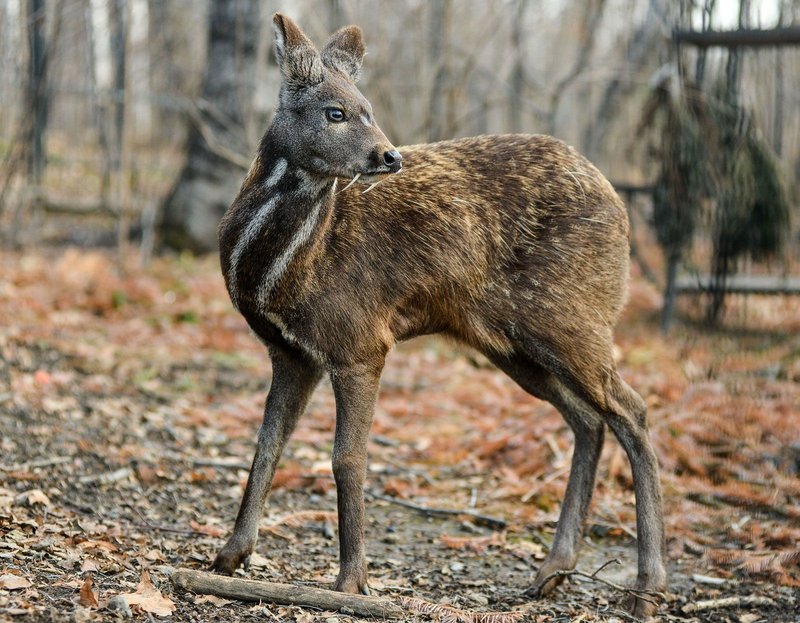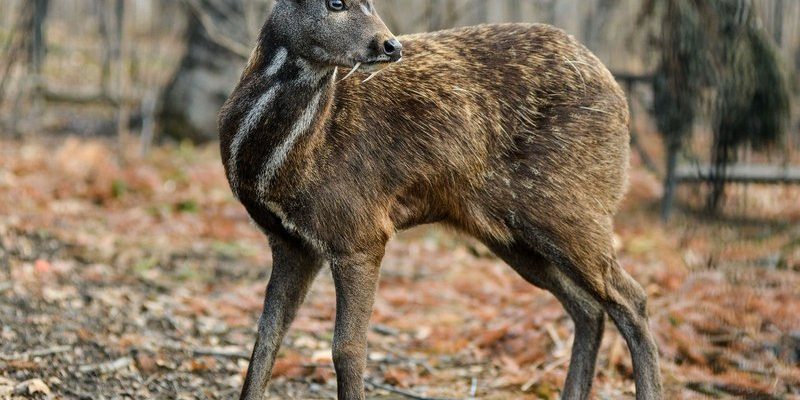
Musk deer are primarily found in the rugged mountains of Asia, including regions in Himalayas, China, and Mongolia. They are often recognized for their distinctive features and fascinating behaviors. So, let’s dive into ten intriguing facts that will leave you appreciating these wonderful creatures even more!
1. They’re Miniature Marvels
Musk deer are much smaller than their more familiar relatives, like white-tailed deer. Most adult musk deer weigh between 20 to 30 pounds, which is about the size of a large house cat! These small deer stand only about 2 to 3 feet tall at the shoulder. Imagine spotting one while hiking in the mountains; you might mistake it for a large rabbit at first!
Even though they’re pint-sized, musk deer are powerful jumpers. They can leap effortlessly over rocks and steep terrain in their mountain habitats. This agility helps them escape predators and navigate their rugged surroundings. Honestly, watching them bounce around in nature is a sight to behold.
2. Unique Antlers? Not Quite!
You might expect all male deer to flaunt impressive antlers, but that’s not the case for musk deer. Instead of antlers, males possess long, sharp canine teeth that can grow up to 2 inches long. These teeth aren’t for munching on food; they’re used during fights with other males, especially during the mating season.
This characteristic gives musk deer a truly distinctive appearance. Their lack of antlers makes them stand out among other deer species. Instead of the typical antlered heads, males look almost like they have a toothy grin. It’s one of those traits that make you say, “Wow, nature really is creative!”
3. The Fragrant Secret
Musk deer get their name from the musk gland, a special organ like a perfume bottle. Located near their genitals, this gland produces a strong, musky scent that males use to attract females. You might think of it as nature’s way of helping a guy make a good impression!
However, this fragrant secretion has led to endangered status for some musk deer species because people have hunted them for musk. The substance is often used in perfumes and traditional medicine. Here’s the thing—while it might seem tempting to collect nature’s treasures, it’s crucial to protect these beautiful creatures and their habitats.
4. They’re Solitary Creatures
Unlike many deer species that roam in herds, musk deer prefer to be on their own. They’re quite the introverts of the animal world! They usually inhabit rocky areas where they can find shelter and remain hidden from predators. This solitary behavior helps them avoid competition for food and mating opportunities.
You might find them grazing on leaves, flowers, and grasses, often in the early morning or late afternoon. Their ability to thrive alone speaks volumes about their adaptability. Just like some of us, they value their personal space!
5. Their Vocalizations Are Unique
Musk deer communicate using a range of vocalizations. Instead of the typical “bleats” you might hear from other deer, they produce high-pitched whistles and clicks. These sounds serve different purposes, like signaling danger or attracting potential mates. Imagine having a secret language just for your closest friends—that’s what musk deer have!
You may not hear these sounds often, as they are typically very quiet animals. But if you find yourself in their habitat, pay close attention. You might catch a glimpse of these fascinating creatures and hear their unique “conversations.”
6. They’re Natural Camouflagers
Musk deer have a wonderful ability to blend into their surroundings. Their fur is typically brownish-grey, which helps them remain hidden among the rocks and foliage of their mountain homes. This natural camouflage is especially useful for evading predators—think of it as their very own invisibility cloak!
When you see a musk deer lounging in the shade, it might take a moment to spot them. They have an innate talent for choosing the perfect resting spots that keep them safe from prying eyes.
7. Pregnant for a Long Time
The gestation period for musk deer is notably long, lasting about 7 to 8 months. That’s quite a wait, especially for such small animals! Females usually give birth to a single fawn, which is typical for many deer species.
After giving birth, females are incredibly protective of their young. They’ll hide the fawn in a safe spot while they forage for food, returning frequently to check on their little one. It’s a heartwarming sight to see a mother musk deer caring for her young, echoing the strong bonds that many animals share.
8. Their Habitat Is Under Threat
Musk deer face significant challenges in their natural habitats. As human populations grow, many of their mountain homes are being destroyed for agriculture and development. Climate change is also impacting their environments, altering the ecosystems they depend on for food and shelter.
Conservation efforts are crucial to protect these majestic creatures and their habitats. Organizations are working to establish protected areas and raise awareness about the importance of preserving these unique deer. It’s a reminder that our actions have a ripple effect on wildlife.
9. Are They Endangered?
Yes, many musk deer species are classified as endangered. Overhunting for their musk and habitat loss have contributed to their decline. Some regions have implemented strict hunting regulations to help protect these fragile populations.
Efforts are underway to conserve their habitats and implement breeding programs for endangered species. Awareness campaigns also play a vital role in educating the public about the importance of protecting musk deer. By supporting these efforts, we can all help ensure that future generations get to marvel at these incredible animals.
10. A Unique Place in Folklore
Musk deer hold a special place in the folklore of many cultures. In some regions, they are viewed as symbols of purity and grace. Their elusive nature often makes them the subject of stories and myths, painting them as magical creatures of the mountains.
Folklore can serve as a powerful reminder of our connection to nature. It helps us appreciate not only the musk deer but also the ecosystems they represent. By sharing these stories, we can help foster respect and admiration for all wildlife.
As you’ve seen, musk deer are not just fascinating for their unique traits, but they also serve as a reminder of the beauty and fragility of our natural world. Let’s treasure these remarkable creatures and do our part to protect them for generations to come!

